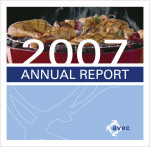



Labelling of Poultry Meat: What's At Stake
This feature is taken from the Avec Annual Report for 2007. A link to the full report is also provided.
In many areas labelling is an aspect that has to be considered. So far Avec has given its position in several cases and this year again labelling has been at stake in different issues.
Marketing standards: definition of fresh and labelling of the origin
The Commission is still working on the amendment of the Regulation (EEC) No 1906/90 on certain marketing standards for poultrymeat. The main marketing standards (conditions, use by date, registered number, price per weight, etc.) should not change but avec advocates a broader definition of fresh poultrymeat and the labelling of origin. Indeed, avec refuses to accept that it will be allowed that defrosted poultrymeat can be marketed in future in a chilled condition even with a mandatory label indicating ‘previously frozen’ unless the frozen raw material after being thawed out has been cooked and not been frozen thereafter. avec requests the introduction of a definition of fresh meat preparation. On the labelling of origin, avec advocates a mandatory labelling of EU origin and a voluntary labelling of the member state origin under strict conditions, but a very small number of members prefer a mandatory labelling of the member state origin as well. The mandatory mention of the slaughter date remains at stake. Labelling both a slaughter date and ‘the used by’ date or ‘minimum durability’ can be seen as superfluous and might create a cluttered situation, but some are using it.
avec position has been presented and taken in consideration by the Commission but as the debate on the approval of the use of decontaminants is still going on there, no official proposal has been made.The outcome is also linked to the simplification procedure of the Common Market Organisation and of WTO negotiations’ results.
As regards to antimicrobial treatments of food of animal origin (legislation in revision as well), avec thinks it is currently superfluous using chemical substances but advocates its mandatory labelling (wording also to be defined) if it is authorised.
General food labelling legislation and feed labelling legislation revisions Is also at stake this year the general food labelling and nutrition labelling regulation, which is still under revision since 2006. The key objective is to update the current rules taking into account the experience gained from current Directives.Already in 2006 avec has communicated its position going in the way to meet consumers’ needs without burdening the industry. A proposal is expected in December 2007.
As well the legislation on feed labelling and authorization/withdrawal procedure of feed materials is under revision. It includes nutritional labelling and claims the indication on the label or on the accompanying documents of all the ingredients of the feedingstuffs including additives, in order to improve traceability, transparency of commercial transactions and information towards users and consumers.A legislative proposal is expected end of 2007.
Avoiding labelling of animal welfare
In the future, an animal welfare label might be introduced as well.This year the European poultry in-dustry escaped the introduction of a mandatory labelling indicating that the product was coming from an animal reared with certain welfare standards.The first draft of the German presidency proposition for a Council Directive laying down minimum rules for the protection of chickens kept for meat production (adopted in June 2007) was containing a sentence mentioning that chicken meat, meat products and preparations should be labelled “EU animal welfare standard” provided that the chickens were kept in compliance with the Directive or under equivalent conditions, otherwise should be labelled “Animal welfare standard not specified”. Finally, it was not introduced. avec is against animal welfare labelling as such, but advocates a comprehensive label covering all European standards, not only animal welfare. Too many labels would confuse consumers.
The general objective of labelling is to inform the consumer.This information has to be essential or relevant for him and may not confuse or mislead him. Stakeholders and legislators have to keep this in mind while working on the various opportunities to change labelling legislation and have to ask themselves whether this information make the consumer more confident in the product.
Further Reading
|
|
Take a look at Avec's Annual Report for 2007 by clicking here. |
November 2007











